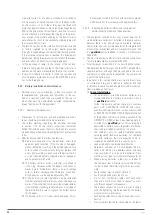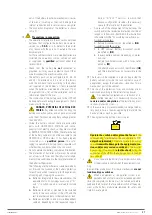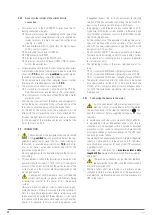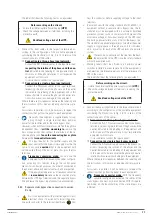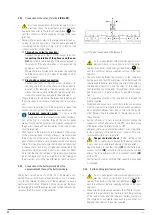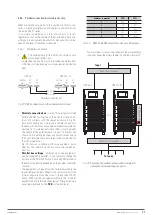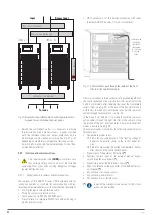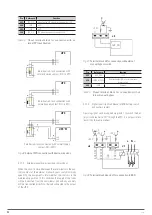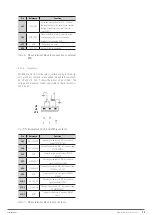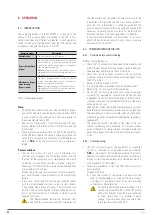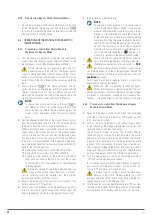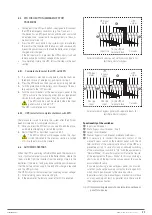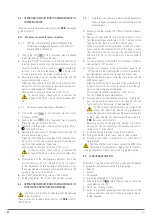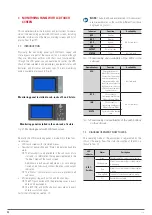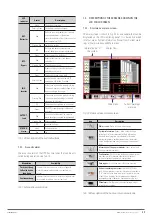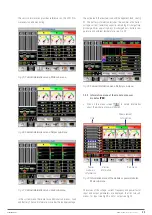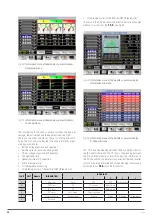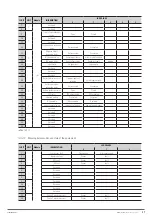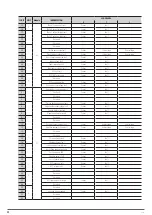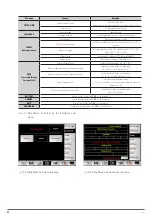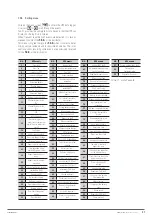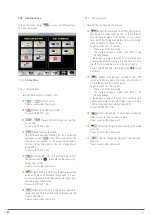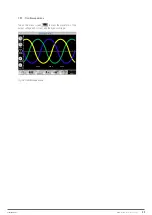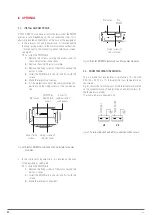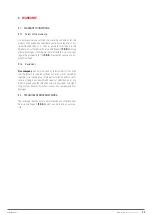
40
SALICRU
6.7. OPERATING INSTRUCTIONS FOR MAINTENANCE OF
POWER MODULES.
These actions are reserved exclusively for the
T.S.S.
personnel
or the distributor.
6.7.1. Maintenance guide for power modules.
6.7.1.1. With the system operating in Normal Mode and the
normal bypass voltage and frequency, with at least 1
power module as redundant:
1.
Click on the icon
in the "Operation" menu to enable
the power module shutdown function.
2.
Using the "On/Off” button next to the LED indications on
the front panel, manually stop the power module. Use an
object of diameter ≤ 3 mm, such as a small screwdriver,
to insert it into the hole indicated as “ ” and press for
around 5-6 seconds on the button located inside.
3.
Remove the fixing screws of the side trim profiles and the
power module fixing screws.
Slightly pull the handle on each end of the module and re-
move it 4-5 cm from the socket to remove it from the con-
nector on the backplane of the device.
Wait around 10 minutes and remove it from its slot.
To ensure safety, check with an instrument the
voltage of the DC bus, which should be below 60 V
DC.
6.7.1.2. No power modules operating as redundant:
1.
Click on the icon
in the "Operation" menu to switch
to "Bypass Mode".
2.
Click on the icon
in the "Operation" menu to enable
the power module shutdown function.
3.
Manually stop the power module by pressing the button “
” for around 5-6 sec.
4.
Remove the fixing screws of the side trim profiles and the
power module fixing screws.
Slightly pull the handle on each end of the module and re-
move it 4-5 cm from the socket to remove it from the con-
nector on the backplane of the device.
Wait around 10 minutes and remove it from its slot.
To ensure safety, check with an instrument the
voltage of the DC bus, which should be below 60 V
DC.
5.
After the end of the maintenance operations, insert the
power module until it is at the end of its slot to connect
to the "backplane" of the equipment. After around 2 min
the power module will activate automatically adding to the
parallel of the rest of the modules.
6.
Insert and tighten the fixing screws of the module.
7.
Fit the side profiles, their screws, and fix them in place.
6.8. OPERATING INSTRUCTIONS FOR MAINTENANCE OF
THE BYPASS AND MONITORING MODULE.
The bypass and monitoring module cannot be operated
in Battery Mode.
These actions are reserved exclusively for the
T.S.S.
staff or
the distributor.
6.8.1.1. With the system operating in Normal Mode and normal
bypass voltage and frequency, transfer the load over the
manual bypass.
1.
Manually stop the inverter. The UPS will transfer to Bypass
Mode.
2.
Remove the mechanical lock of the manual bypass switch
from the external panel and turn it to "On". The load will be
fed directly from the mains via the manual bypass.
When a protection panel is provided instead of a manual
bypass panel, the mechanical lock of the bypass switch
from the back of the sub-rack must be removed manually
and turn it to "On" as this switch will not be available in
the panel.
3.
Turn the protection or the battery circuit breaker of the bat-
tery cabinet to "Off" position.
4.
Turn the circuit breakers of the manual bypass panel to the
“Off” position in the following order: Output, Input and By-
pass [equipment version B, with separate bypass line].
5.
Remove the fixing screws of the side trim profiles and the
MBS fixing screws.
Slightly pull the handle on each end of the module and re-
move it 4-5 cm from the socket to remove it from the con-
nector on the backplane of the device.
Wait around 10 minutes and remove it from its slot.
Carry out the appropriate maintenance.
6.
After the end of the maintenance operations, insert the by-
pass and monitoring module until it is at the end of its slot
to connect to the "backplane" of the equipment.
All UPS configuration parameters are stored in the
bypass and monitoring module. Any replacement
entails the necessary programming of the same parameters
as the original module. This task is reserved exclusively for
T.S.S.
personnel or distributors.
Replacing one bypass module with another one without
carrying out the corresponding configuration can lead to
serious or very serious faults.
7.
Insert and tighten the fixing screws of the module.
8.
Fit the side profiles, their screws, and fix them in place.
9.
Proceed as described in section 6.4.2. to switch back to
Normal Mode.
The force that has to be made to connect the MBS to the
backplane of the equipment is higher than for the MPs,
since the terminals of the connector are of a greater section.
6.9. LANGUAGE SELECTION.
The menus displayed on the LCD touch screen and the display
of parameters and data are available in 3 languages:
•
Spanish.
•
English.
•
Portuguese.
To select a language, perform the following:
1.
Click on the icon
within the main menu to enter the
setup menu on the LCD.
2.
Select the “Language” menu.
3.
Select the required language. From this moment all the
menus, parameters and data will be displayed in the se-
lected language.

